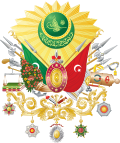
Back قائمة سلاطين الدولة العثمانية Arabic سلاطين الدوله العثمانيه ARZ Osmanlı sultanlarının siyahısı Azerbaijani عثمانلی سولطانلارینین لیستی AZB Ғосман империяһы солтандары исемлеге Bashkir Асманскія султаны Byelorussian Списък на османските султани Bulgarian উসমানীয় সাম্রাজ্যের সুলতানদের তালিকা Bengali/Bangla Roll Sultaned an Impalaeriezh Otoman Breton Sultani Osmanskog Carstva BS
| Sultan of the Ottoman Empire | |
|---|---|
| Osmanlı padişahı | |
Imperial | |
 | |
 | |
| Details | |
| Style | His Imperial Majesty |
| First monarch | Osman I (c. 1299–1323/4) |
| Last monarch | Mehmed VI (1918–1922) |
| Formation | c. 1299 |
| Abolition | 1 November 1922 |
| Residence | Palaces in Istanbul:
|
| Appointer | Hereditary |



The sultans of the Ottoman Empire (Turkish: Osmanlı padişahları), who were all members of the Ottoman dynasty (House of Osman), ruled over the transcontinental empire from its perceived inception in 1299 to its dissolution in 1922. At its height, the Ottoman Empire spanned an area from Hungary in the north to Yemen in the south and from Algeria in the west to Iraq in the east. Administered at first from the city of Söğüt since before 1280 and then from the city of Bursa since 1323 or 1324, the empire's capital was moved to Adrianople (now known as Edirne in English) in 1363 following its conquest by Murad I and then to Constantinople (present-day Istanbul) in 1453 following its conquest by Mehmed II.[1]
The Ottoman Empire's early years have been the subject of varying narratives, due to the difficulty of discerning fact from legend. The empire came into existence at the end of the 13th century, and its first ruler (and the namesake of the Empire) was Osman I. According to later, often unreliable Ottoman tradition, Osman was a descendant of the Kayı tribe of the Oghuz Turks.[2] The eponymous Ottoman dynasty he founded endured for six centuries through the reigns of 36 sultans. The Ottoman Empire disappeared as a result of the defeat of the Central Powers, with whom it had allied itself during World War I. The partitioning of the Empire by the victorious Allies and the ensuing Turkish War of Independence led to the abolition of the sultanate in 1922 and the birth of the modern Republic of Turkey in 1922.[3]
- ^ Stavrides 2001, p. 21
- ^ Kafadar 1995, p. 122. "That they hailed from the Kayı branch of the Oğuz confederacy seems to be a creative "rediscovery" in the genealogical concoction of the fifteenth century. It is missing not only in Ahmedi but also, and more importantly, in the Yahşi Fakih-Aşıkpaşazade narrative, which gives its own version of an elaborate genealogical family tree going back to Noah. If there was a particularly significant claim to Kayı lineage, it is hard to imagine that Yahşi Fakih would not have heard of it."
Lowry 2003, p. 78. "Based on these charters, all of which were drawn up between 1324 and 1360 (almost one hundred fifty years prior to the emergence of the Ottoman dynastic myth identifying them as members of the Kayı branch of the Oguz federation of Turkish tribes), we may posit that..."
Lindner 1983, p. 10. "In fact, no matter how one were to try, the sources simply do not allow the recovery of a family tree linking the antecedents of Osman to the Kayı of the Oğuz tribe. Without a proven genealogy, or even without evidence of sufficient care to produce a single genealogy to be presented to all the court chroniclers, there obviously could be no tribe; thus, the tribe was not a factor in early Ottoman history." - ^ Glazer 1996, "War of Independence"
© MMXXIII Rich X Search. We shall prevail. All rights reserved. Rich X Search